Imagine stepping into an office space for the first time—what’s one of the first things you usually notice? The office signage! It’s everywhere, quietly guiding you around. From friendly signs pointing toward the restrooms and clear directions leading to the fire exits to the impressive 3D embossed welcome sign greeting you warmly at the reception desk, signage is your subtle companion throughout your visit. Often, it’s something you only notice when you need it most.
Great office signage doesn’t just direct traffic—it helps create a welcoming, engaging, and safe environment for everyone. Whether you’re guiding employees effortlessly through a large building, highlighting your brand’s personality, or ensuring important safety details are easy to spot, the right signage transforms your workspace from good to great.
Ready for inspiration? Here are 18 of the best office signage ideas to elevate your workspace!
1. Wayfinding Signage
Wayfinding signage is crucial for helping visitors and employees navigate large or multi-floor offices. Clear, easily understandable signage can reduce confusion, improve efficiency, and enhance the experience of your space. Wayfinding signs should be designed with simplicity and clarity in mind. They should use large fonts and universally recognizable symbols, such as arrows or exit signs.
In large office spaces, color-coding can be a highly effective method for guiding individuals to various departments, restrooms, and other essential facilities. You can also use floor and wall signage, ceiling-mounted signs, and even interactive kiosks to provide directions. The placement of these signs should be strategic, at notable junctions, near elevators, or high-traffic areas.
Tip: Consider digital wayfinding signs that update automatically in real time to reflect changes in meeting room availability or office configurations.
2. Interactive Digital Signage
Digital signage is an innovative and dynamic way to display information in a modern office. These screens can show real-time updates, advertisements, meeting schedules, and more, keeping your office environment vibrant and up-to-date.
Interactive digital signage can be used for various purposes, such as displaying the company’s announcements, real-time event schedules, or emergency alerts.
This technology can be customized with engaging multimedia content, including videos and social media feeds. In high-traffic areas like lobbies, hallways, or break rooms, digital signage can provide value by ensuring employees and visitors are constantly informed. Many digital displays allow users to interact with them, making them informative and engaging. For example, you can have an interactive kiosk in the reception area to guide visitors through the office layout.
3. ADA Compliant Signage

Americans with Disabilities Act (ADA) compliant signage is essential for creating an inclusive and accessible workplace. These signs ensure that all individuals can easily navigate the office regardless of ability.
ADA-compliant signage typically includes tactile elements like Braille and raised text, which individuals with visual impairments can read.
It’s also essential to ensure that signage meets specific contrast guidelines, and signs should be evident for those with limited vision. Restrooms, elevators, fire exits, and other essential spaces must all have compliant signage. For additional accessibility, you can also consider signs with audible cues. These signs must be placed at an appropriate height for easy reading by all individuals, including those in wheelchairs.
4. Fire Safety Signage
Fire safety signage is crucial for protecting employees and visitors in an emergency. These signs indicate evacuation routes, emergency exits, and the location of safety equipment. Office signage ideas for fire safety include exit signs, fire extinguisher location markers, and instructions for emergency evacuation. These signs must be visible and placed near exits, stairwells, and elevators.
In some cases, fire safety signage should be illuminated, ensuring that it remains visible even in low light or emergencies. In addition to exit signs, consider including fire safety instructions in communal spaces like kitchens or break rooms, where employees may need guidance on using fire extinguishers or performing basic fire safety measures.
5. Photoluminescent Demarcation
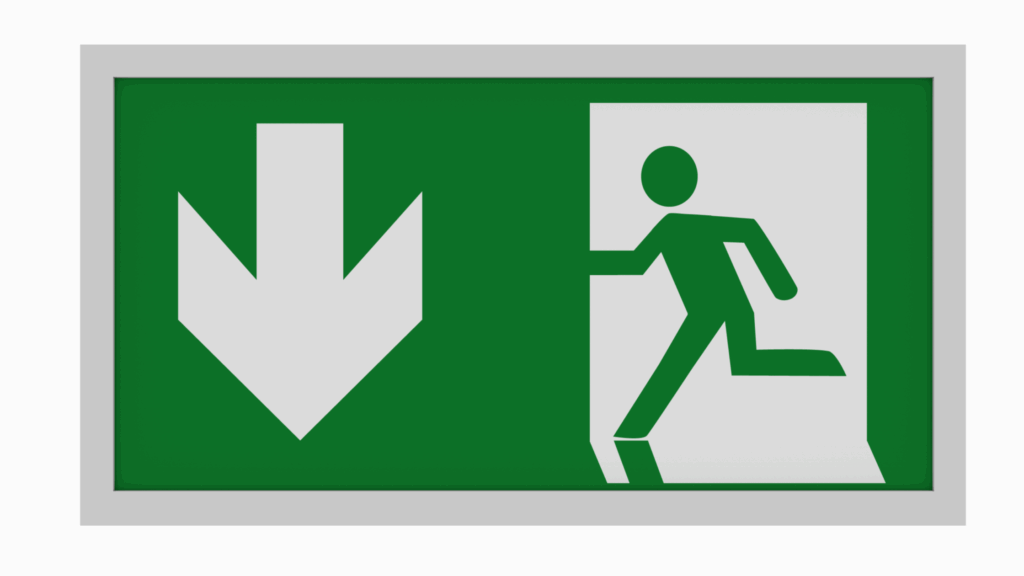
Photoluminescent signs and demarcation lines are ideal for low-light environments. They glow in the dark, providing essential guidance during power outages or emergencies.
Photoluminescent demarcation is perfect for marking paths, stairways, and exits.
These signs absorb light and can continue glowing for several hours, making them highly visible even in total darkness. This feature is particularly useful in buildings prone to power outages or high-traffic areas requiring continuous guidance, such as stairwells, corridors, and fire exits. Photoluminescent materials are often used for floor markings or stair treads to guide employees safely through the workspace in emergencies.
Pro Tip: Install these signs strategically near staircases, exits, and emergency assembly points.
6. Branding Wall Graphics
Wall graphics can reinforce your brand identity and create an inspiring, unified environment. These graphics can be large-scale murals or more minor signs with company logos, mission statements, or core values.
Office signage ideas using branding wall graphics are an effective way to make a bold statement and boost your company’s identity.
These signs can be placed in lobbies, meeting rooms, and hallways to reinforce your brand consistently. They can showcase your company’s logo, tagline, or core values, constantly reminding you of your company culture. Wall graphics can also be artistic, offering employees a space to reflect on the company’s journey, achievements, and vision.
7. Interactive Kiosks

Interactive kiosks are a modern and highly engaging way to help visitors and employees access information. These self-service systems can display directories, schedules, and provide helpful office-related data.
Interactive kiosks can be used in the reception area or near common areas, allowing employees and visitors to check in, find meeting rooms, view office amenities, and more.
These kiosks often include touchscreen interfaces that are easy to navigate, offering users a customized experience. You can also integrate real-time information, such as meeting schedules, available conference rooms, or upcoming company events.
8. Conference Room Availability Displays
Managing the availability of meeting spaces can be challenging, especially in large organizations. Conference room availability displays help streamline this process by showing real-time information on room bookings.
These office signage ideas using digital displays can be placed outside meeting rooms to show if the room is available, booked, or in use.
They can be integrated with calendar systems to provide real-time updates. This signage can also show details of the current meeting and the time of the next booking, helping employees efficiently plan meetings and reduce scheduling conflicts.
Tip: Use color coding (green for available, red for occupied) for easy recognition.
9. Reception Area Signage
The reception area is the first place visitors encounter, making it the perfect spot for signage that reflects your brand and welcomes guests.
A clear and inviting reception sign featuring your company’s logo and tagline sets a professional tone. Additional signage in the reception area can direct visitors to check in, indicate office hours, or provide information about company policies.
Digital displays in the reception area can also enhance the experience by showing upcoming meetings, employee achievements, or company events.
10. Restroom Signage
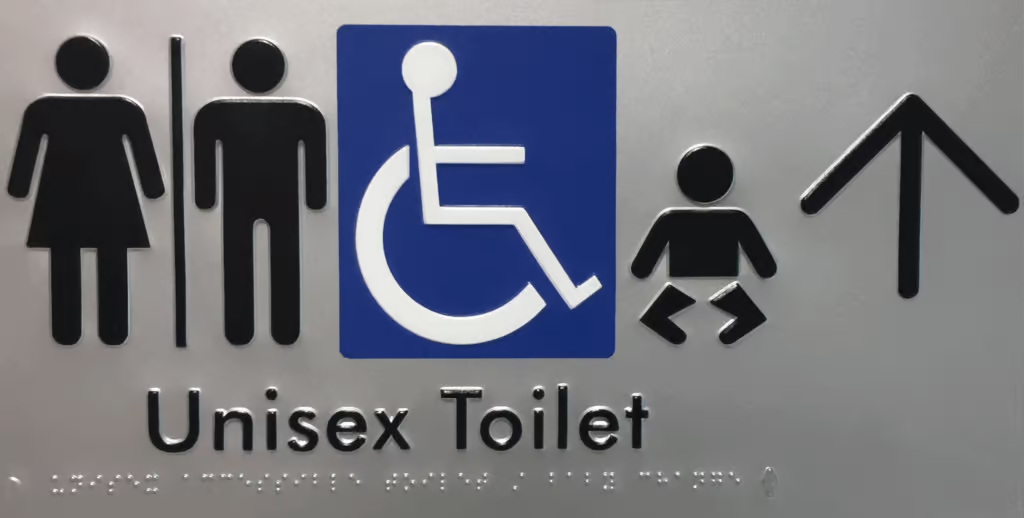
Clear restroom signage is essential in every office to comply with ADA guidelines and ensure easy access for all employees and visitors. Restroom signs should be simple, universally recognizable, and include gender-neutral options to accommodate everyone. Following ADA standards, signs must feature large, high-contrast fonts and internationally recognized symbols for maximum visibility.
Proper placement is crucial—ADA regulations recommend signs be positioned at an accessible height and visible from a distance. Additionally, Braille and tactile text should be incorporated to enhance accessibility further and support visually impaired individuals.
11. Departmental Signs
Departmental signage helps organize the workspace by clearly marking different office sections. This allows visitors to find the correct departments and makes it easier for employees to locate different teams.
Departmental signage should include the department’s name; icons or color-coding can make it easier to navigate.
For instance, a finance department sign could consist of a dollar sign or a calculator icon. Ensure that the fonts are large enough to be seen from a distance, and that the signs are placed at eye level. Consistent branding across all department signs will help tie the office together visually and reinforce your company’s identity.
Tip: To reduce confusion in open office plans, place these signs at key decision points, such as near entrances or intersections.
12. Emergency Exit Signs
Emergency exit signs are crucial for workplace safety, especially during emergencies such as fires, as mandated by OSHA guidelines. These signs help employees and visitors quickly identify and reach the nearest safe exit.
OSHA requires emergency exit signs to be illuminated and strategically placed near every exit door, stairwell, corridor, and path leading to an emergency exit.
OSHA also emphasizes providing clear instructions on evacuation routes and safety procedures alongside these signs. Illuminated or glow-in-the-dark signage is important to comply with OSHA’s visibility and readability standards during emergencies.
13. Visitor Information Boards
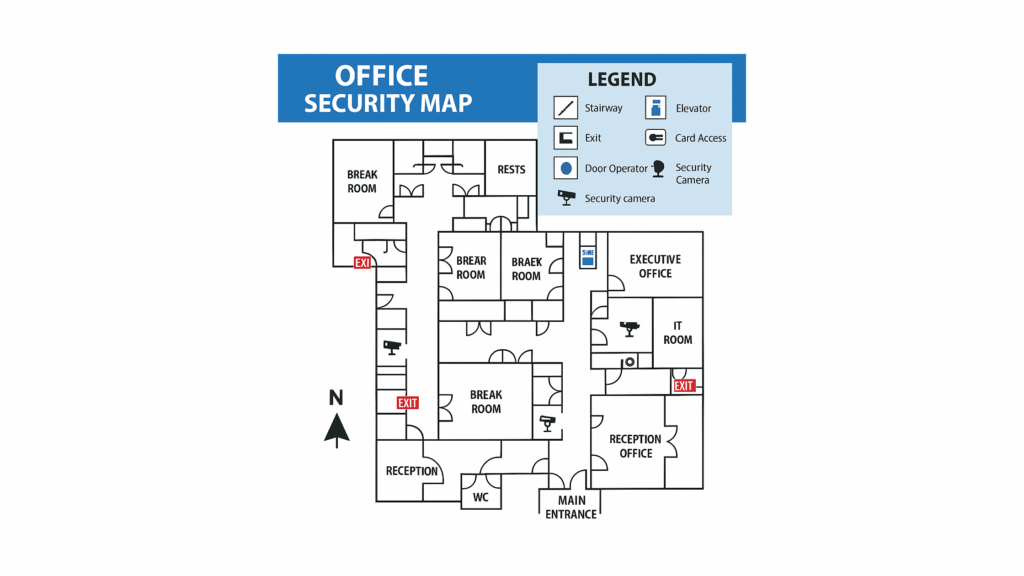
Visitor information boards provide helpful information for guests arriving at your office. These boards can display visitor policies, office hours, health and safety protocols, or directions to key facilities.
This signage should be prominently displayed in the reception area and should include useful details such as where visitors should check in, where they can find restrooms, and any visitor policies related to health and safety. You may also want to include emergency protocols or maps of the office building. Depending on your office setup, this board can be digital or physical.
14. Sustainability Messaging

Sustainability messaging can help reinforce your company’s commitment to environmentally friendly practices. These signs can encourage recycling, energy-saving habits, and waste reduction.
Prominently place sustainability signs near recycling bins, light switches, and communal kitchens or break areas.
These signs should feature simple instructions on recycling or reminders about turning off lights or equipment when not in use. You can also showcase your company’s sustainability goals, such as energy savings, waste reduction, or sustainability certifications.
15. Interactive Feedback Stations
Interactive feedback stations provide employees with an opportunity to share their opinions and suggestions conveniently and engagingly. This can help foster a sense of involvement and collaboration.
Feedback stations can be as simple as digital kiosks where employees can fill out surveys, or they can be physical suggestion boxes where employees can drop comments.
The key is to make the process simple, user-friendly, and non-intimidating. Employees should feel comfortable providing constructive feedback. Making it interactive ensures that feedback is collected regularly and is a two-way communication channel.
16. Directional Floor Decals
Floor decals are a subtle but effective way to guide people through large or open-plan offices. These markings can be used to point to restrooms, break rooms, or meeting rooms. These decals should be durable and at parts of your workplace where construction is taking place.
These decals are one of the best office signage ideas because they can be placed on the floor to help guide employees and visitors without taking up wall space.
17. Accessibility Pathways
Accessibility pathways are crucial for creating an inclusive office environment that complies with ADA guidelines and ensures ease of navigation for individuals with mobility challenges. According to ADA accessibility standards, these pathways must be clear, unobstructed, and distinctly marked. Utilize floor decals, tactile strips, or other compliant signage to highlight accessible routes.
Moreover, ADA requires stairs, elevators, and accessible corridors, doorways, and common areas to be indicated. Pathways must also be wide enough to comfortably accommodate wheelchairs and other mobility devices, with signage directing users along the safest and most convenient accessible route. Additionally, ADA standards recommend placing accessible signage at eye level, using high-contrast colors for enhanced visibility.
18. Seasonal or Event Signage
Seasonal signage can add a festive touch to the office and foster a sense of community. It can mark holidays, birthdays, company events, or special milestones.
Seasonal signage is a great way to build excitement and keep employees engaged. Consider displaying signs for company-wide events, team-building activities, or community service projects.
Holiday signage can also add a personal touch to the workplace and encourage employees to participate in office celebrations. This could include digital displays or physical banners and posters. Effective office signage ideas do more than just inform—they enhance the entire workspace by improving clarity, reinforcing your brand, promoting safety, and boosting overall engagement. If your office or facility needs signage, you must partner with professionals who understand signage design, compliance, and functionality inside and out. That’s why so many businesses trust GS Parcel.
GS Parcel is Your Choice for Accurate & Compliant Office Signage Solutions

At GS Parcel, we do more than just install signs—we create comprehensive signage solutions that improve navigation, ensure safety, and elevate the overall experience within your building.
Whether you require ADA-compliant room identifiers, restroom signs, photoluminescent egress path markings, directory boards, or clearly marked emergency exits, our solutions guide visitors and staff with unmatched clarity while meeting OSHA, ADA, and local compliance standards.
We proudly serve a wide range of facilities, including corporate offices, hospitals, universities, libraries, residential complexes, and more. From initial consultation and custom design planning to precise fabrication and expert installation, our experienced team seamlessly manages every step of the process.
Ready to transform your facility with superior commercial signage solutions? Speak with a GS Parcel specialist at (866) 233-3597 or request a call here.
Let’s build smarter, safer, and more welcoming spaces—together.
